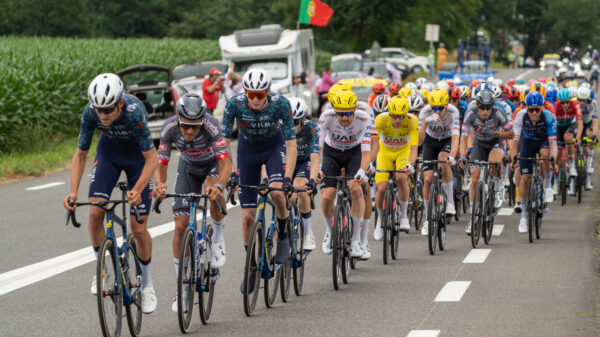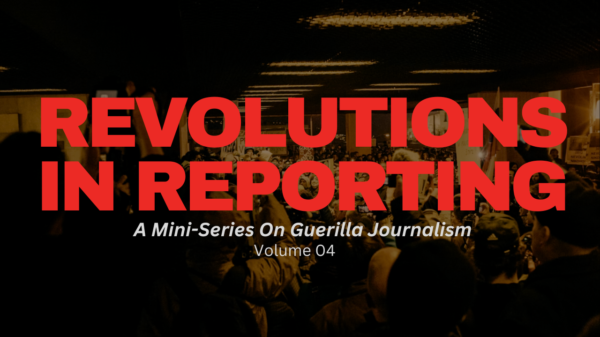Staff writer Alisa Sheludko examines the implications of guerrilla journalism on traditional news media and the possibility of their collaboration in the future.
Introduction
In recent years, guerilla journalism has become one of the most discussed developments in the study of journalism. The novel format of amateur-led news creation has left many to fear the disappearance of traditional media in the face of guerilla journalism that presents novel and attractive qualities. However, while it has certainly had an impact on the production and presentation of traditional media, it is unlikely to entirely replace it because of the plethora of ethical and legal issues it raises.
Guerilla journalism is one of the innumerable strands of citizen journalism. Much like other types of citizen journalism, guerilla journalism is defined by the fact that the news content it disseminates is produced by amateurs instead of professional journalists. Usually shared via social media, guerilla journalism actively engages ordinary public members in “collecting, reporting, analysing and disseminating news and information.”
However, activism is the principal trait distinguishing guerilla journalism from other forms of citizen journalism. Guerilla journalism usually centres around a particular issue and stems from the public’s dissatisfaction with traditional news coverage. Thus, guerilla journalism actively challenges mainstream narratives and often embodies a hostile attitude towards conventional media.
Shift to digital platforms and the rise of guerilla journalism
The advent of the internet has been instrumental to the rise of guerilla journalism. As highlighted by academic Rabia Noor, the terms guerilla and citizen journalist only began to appear with the broader internet accessibility to the public.
The novel interactive features of social media apps such as YouTube, Facebook, and Twitter allow people to share and interact with news information easily in real-time. For instance, images of disasters and highly important events ranging from 9/11, 7/7, the Iraq War, Hurricane Katrina and the Mumbai attacks began to flood the internet, making amateur media users transform into both the creators and consumers of news media.
Besides allowing for the birth of guerilla journalism, the rapid growth of digital technology and the genesis of the internet have also constrained traditional media to compete with this emerging form of journalism.
Changing audience habits have favoured the convenience and accessibility of digital news, forcing significant newspapers, such as the New York Times, to relocate their products to the Internet. During March 2005 alone, the New York Times website was visited by 15 million unique views – five times the number of the Times’s print edition. This phenomenon has forced traditional media to vie for importance in a digital space where guerilla journalism appears much more attractive to newsreaders.
The first advantage guerilla journalism presents to readers is the high speed at which information is available. Citizen’s ability to film content and upload it online before media organisations can even get there has reduced the audience’s reliance on mainstream media.
As seen through the recent example of the Russian invasion of Ukraine, which has been termed the first ‘TikTok war.’ Ukrainian guerilla journalists are often able to inform audiences of breaking news much faster than reputable media outlets, thus reducing the relevance and impact of traditional media.
The second quality which makes guerilla journalism preferable to traditional media for audiences is its authenticity and interactive quality. Individuals from different backgrounds produce guerilla news content and do not go through an editor, thus preserving its authors’ rawness and unique voice.
This can make guerilla journalism particularly attractive in cases where the public considers official news coverage too restrained or biased. According to academic Gabe Mythen, guerilla journalism was born during the 1988 presidential election when the American public, disillusioned with the lacklustre nature of official coverage, resorted to producing and distributing media that put forward their interpretation of events.
The attractiveness of guerrilla journalism has forced traditional media to adopt new ways of presentation to remain relevant. Most major newspapers, such as The Economist and The New York Times, present news in short formats through Instagram or Twitter, allowing audiences to interact with traditional media content, thereby preserving the appeal of the authentic and interactive quality of guerilla journalism.
Similarly, to maintain relevance, traditional broadcasting companies such as BBC and CNN often use user-generated content as the basis for newsgathering. In some instances, newspapers have even created spaces for their readers to share and discuss user-generated news through online platforms such as CNN’s iReport feature and Al-Jazeera’s Sharek Portal.
Ethical considerations and legal risks of guerilla journalism
The rise of guerilla journalism in recent years has significantly affected how traditional media news is researched and presented. Nevertheless, despite the initial predictions of media researchers, it is unlikely that conventional journalism will end because of guerilla journalism. The independent nature and fast diffusion of guerilla news that are responsible for its chief virtues also pose considerable ethical and legal problems.
The concept of expertise is a notable issue, for instance. Guerilla journalists usually lack the editorial judgement traditional journalists acquire through years of work in a professional environment with constant editorial supervision. This often results in the inability to look beyond the sensational to select news content that would inform audiences and carry genuine analytical value. Guerilla journalists usually resort to the diffusion of shocking on-the-spot images, such as those of police brutality in Kashmir.
As stated by Mythen, the elevation of the sensational poses serious ethical questions as it often carries little value for audiences and only serves to upset viewers and encourage a reprehensible display of human suffering. The publication of shocking images and videos also generates far more social media engagement, outshining traditional media’s balanced and analytical coverage, which risks encouraging audiences’ pursuit of the needlessly sensational.
Similarly, the lack of duty towards audiences due to the lack of editorial oversight and other accountability measures amongst guerilla journalists also poses ethical and legal problems. As argued by a broadcaster journalist interviewed by academic, Henrik Örnebring:
“A journalist who publishes a story without verification of his or her sources makes a professional and deontological mistake. Common people are not compelled to do it.”
Henrik Örnebring
The risk is further aggravated by the anonymity of guerrilla journalism, which prevents identification and legal accountability for any malpractices. Some famous examples include the publication of false videos of continuous bombardment in Syria on Al-Jazeera’s online citizen journalism portal Sharek. Although the channel later identified the images as fake, those responsible for publications went unpunished, which made it difficult to enforce legal compliance with ethical standards amongst guerilla journalists.
These issues that thrive in the independent environment of guerilla journalism have motivated traditional media to formulate a distinct professional identity to accentuate its virtues. In a study conducted by Örnebring, it is revealed that the advent of guerilla journalism has strengthened the professional project of traditional journalism by distinguishing what differentiates it from new forms of citizen media. Journalists now pinpoint the existence of an experienced collective and practices in media institutions as qualities that make their work more reliable and ethical. As reported by one of the interviewed journalists:
Henrik Örnebring
The notions of professionalism and reliability that have characterised traditional media have granted it a distinct set of qualities, such as trustworthiness and accountability, that will allow it to thrive alongside guerilla journalism. However, the definition of the professional project in traditional news media means that future collaboration between conventional and guerilla media will remain limited, and the two are more likely to continue developing as separate practices.
While some experts have expressed interest in further embracing guerilla media’s influence on traditional journalism by requiring limited journalistic training on the latter, such projects are unlikely to succeed. The desire to impose gatekeeping measures of guerilla journalism is contrary to the qualities of authenticity for which it is praised and, most importantly, is contradictory to the principles that drive it.
As discussed previously, guerilla journalism is defined by its subversive nature and general hostility towards dominant media narratives. Thus, while these projects may enjoy limited success with other strands of citizen journalism, guerilla and traditional media are most likely to remain separate and complementary ways of diffusing news information.
Conclusion
Guerilla journalism has altered how traditional news media researches and presents their news. To remain relevant in the fast-paced world of user-generated content, traditional media has begun to allow greater interactivity with their work and have often used media produced by guerilla journalism to complement their research.
However, due to the ethical and legal challenges associated with guerilla media, the two are unlikely to compete with one another further. The appearance of guerilla journalism has highlighted the virtues of conventional journalists that differentiate them from amateurs and accentuated its continued necessity.

















